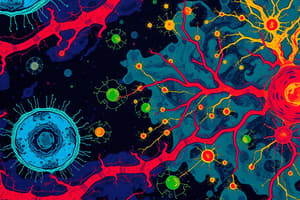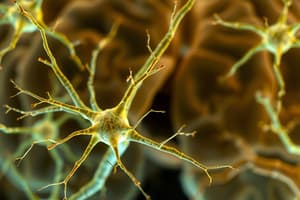Podcast
Questions and Answers
Which type of glial cell is primarily involved in forming tracks for newly formed neurons to migrate along?
Which type of glial cell is primarily involved in forming tracks for newly formed neurons to migrate along?
- Microglia
- Embryonic radial glia (correct)
- Oligodendrocytes
- Astrocytes
What is the primary function of the cerebral spinal fluid?
What is the primary function of the cerebral spinal fluid?
- To regulate glial cell growth
- To provide insulation to neurons
- To serve as a neurotransmitter
- To fill the ventricles and central canal in the brain (correct)
Which neurotransmitter pathways are primarily affected in schizophrenia?
Which neurotransmitter pathways are primarily affected in schizophrenia?
- Acetylcholine pathways
- Norepinephrine pathways
- Dopamine pathways (correct)
- Serotonin pathways
What is a characteristic of Alzheimer's disease?
What is a characteristic of Alzheimer's disease?
Which treatment can help reduce the severity of symptoms in Parkinson's disease?
Which treatment can help reduce the severity of symptoms in Parkinson's disease?
Flashcards
White Matter
White Matter
Bundles of myelinated axons, responsible for transmitting signals throughout the nervous system.
Gray Matter
Gray Matter
Consists of neuron cell bodies, dendrites, and unmyelinated axons, involved in processing information.
Astrocytes
Astrocytes
Glial cells that contribute to the blood-brain barrier, regulating substances entering the brain.
Cerebrospinal Fluid
Cerebrospinal Fluid
Signup and view all the flashcards
Schizophrenia
Schizophrenia
Signup and view all the flashcards
Study Notes
White and Gray Matter
- White matter is composed of myelinated axons.
- Gray matter comprises neuron cell bodies, dendrites, and unmyelinated axons.
Glial Cell Types and Functions
- Glial cells (glia) support and regulate neurons.
- Embryonic radial glia: Form tracks for neuron migration.
- Astrocytes: Help form the blood-brain barrier, restricting substance entry into the brain.
- Some glia act as stem cells, capable of self-renewal and differentiation into specialized cells.
Cerebrospinal Fluid (CSF)
- CSF is a clear, colorless liquid filling brain ventricles and the spinal cord's central canal.
Language and Speech Areas
- Broca's Area: Understanding language, but unable to produce spoken language.
- Wernicke's Area: Unable to comprehend language, but can speak.
Schizophrenia
- Characterized by hallucinations and delusions.
- Affects neuronal pathways using dopamine as a neurotransmitter.
Alzheimer's Disease
- Leads to mental deterioration (dementia), marked by confusion and memory loss.
- Associated with amyloid plaques and neurofibrillary tangles in the brain.
- Results in neuronal death and significant brain tissue shrinkage.
- Currently, no cure.
Parkinson's Disease
- A motor disorder caused by the death of dopamine-secreting neurons in the midbrain.
- Symptoms include tremors, flexed posture, and a shuffling gait.
- Treatable but incurable.
- L-dopa, a dopamine-related drug, can reduce symptoms.
Studying That Suits You
Use AI to generate personalized quizzes and flashcards to suit your learning preferences.



